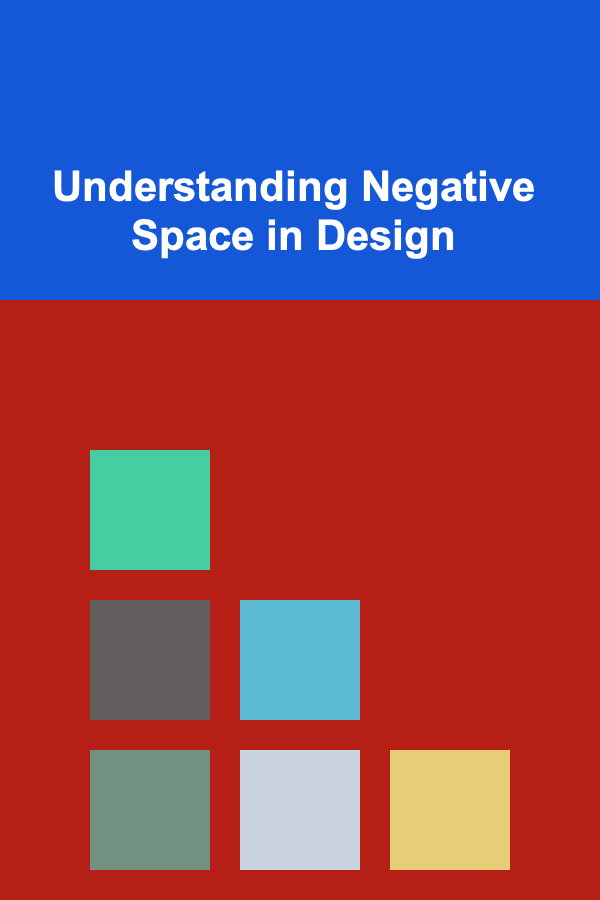
Understanding Negative Space in Design
ebook include PDF & Audio bundle (Micro Guide)
$12.99$10.99
Limited Time Offer! Order within the next:

Negative space, often overlooked and misunderstood, is a fundamental element of design that plays a crucial role in visual communication. It's not just the empty area surrounding an object; it's an active component that contributes significantly to the overall aesthetic, clarity, and effectiveness of a design. This comprehensive guide delves into the intricacies of negative space, exploring its definition, different types, its impact on various design disciplines, and practical tips for mastering its use.
What is Negative Space? A Deeper Dive
At its simplest, negative space, also known as white space, is the area around and between the subjects of an image or design. It's the background, the areas left unmarked, or the spaces deliberately left blank. However, to consider it merely as "empty space" is a gross simplification. Negative space actively shapes our perception of the positive space -- the elements that are deliberately placed or drawn -- and vice versa. The interaction between positive and negative space creates visual relationships, establishes hierarchy, and influences the overall mood and message conveyed by the design.
Think of it like music. Notes are the positive elements, the sounds we consciously hear. But the silences between the notes, the pauses and rests, are equally important. They provide rhythm, emphasis, and allow the notes to resonate more powerfully. Similarly, negative space allows the positive elements in a design to "breathe," preventing visual clutter and improving readability and comprehension.
The concept extends beyond simple visuals. In user interface (UI) design, whitespace around buttons and text boxes is critical for usability. In architecture, the open areas and courtyards are as integral to the design as the built structures themselves. In writing, paragraph breaks and short sentences create negative space that aids readability and allows the reader to absorb information more effectively.
Types of Negative Space
Negative space isn't a monolithic entity. It can be categorized based on its structure and purpose. Understanding these categories allows for more strategic and effective application of negative space in design.
Macro Negative Space
Macro negative space refers to the large areas of emptiness within a design. It's the substantial whitespace that dominates the overall composition. Its primary function is to create visual hierarchy and separate major sections or elements. For example, a website homepage with large blocks of text and images separated by generous whitespace utilizes macro negative space to guide the user's eye and improve scannability.
The strategic use of macro negative space contributes to a feeling of elegance and sophistication. It's often employed in minimalist designs and high-end branding to convey a sense of luxury and exclusivity. Too little macro negative space can lead to a cluttered and overwhelming design, while too much can result in a feeling of emptiness and lack of engagement.
Micro Negative Space
Micro negative space refers to the small pockets of emptiness between individual elements within a design. This includes the spacing between letters (kerning), the space between lines of text (leading), and the margins around individual elements within a layout. While seemingly insignificant, micro negative space plays a crucial role in legibility and readability.
Proper kerning, for example, ensures that letters don't collide or appear too far apart, creating a smooth and visually pleasing reading experience. Adequate leading (line height) prevents lines of text from feeling cramped and improves eye tracking. The margins around text boxes and images provide visual breathing room, preventing them from feeling suffocated by the surrounding elements.
The meticulous application of micro negative space is often the hallmark of professional design. It demonstrates attention to detail and a commitment to user experience. Even subtle adjustments to kerning or leading can significantly impact the perceived quality and professionalism of a design.
Active vs. Passive Negative Space
This classification focuses on the intent behind the use of negative space. Passive negative space is simply the space that remains after the positive elements have been placed. It serves a functional purpose, providing separation and visual breathing room, but it doesn't actively contribute to the design's message or aesthetic.
In contrast, active negative space is deliberately shaped and used to create a specific visual effect or convey a hidden meaning. This is where the real power of negative space comes into play. Designers can use active negative space to create optical illusions, reveal hidden shapes, or subtly reinforce the overall theme of the design.
A classic example is the FedEx logo. The space between the "E" and the "x" forms a subtle arrow, which unconsciously communicates speed, direction, and precision -- key attributes of the FedEx brand. This is a prime example of active negative space being used to enhance the brand's message.
The FedEx logo demonstrating active negative space creating an arrow.
The Impact of Negative Space on Different Design Disciplines
The principles of negative space are universally applicable across various design disciplines, but their specific application and impact may vary depending on the medium and the goals of the design.
Graphic Design
In graphic design, negative space is a critical tool for creating visually appealing and effective compositions. From logo design to poster layouts, the strategic use of negative space can enhance visual hierarchy, improve readability, and create a memorable impact. Logos that effectively utilize negative space often become instantly recognizable and iconic.
For example, a logo for a dental clinic might incorporate the shape of a tooth within the negative space of a smiling face, creating a clever and memorable visual pun. A poster for a concert might use negative space to create a sense of depth and dimension, drawing the viewer's eye into the design.
Web Design/UI Design
In web design and UI design, negative space is paramount for usability and user experience. Whitespace around buttons, text boxes, and other interactive elements allows users to easily identify and interact with them. Generous whitespace between sections of content improves scannability and reduces cognitive load.
A clean and spacious UI design, achieved through the effective use of negative space, can significantly improve user satisfaction and engagement. A cluttered and cramped UI, on the other hand, can lead to frustration and abandonment. Mobile app design, in particular, benefits from strategic use of whitespace to accommodate smaller screen sizes and improve touch target accuracy.
Photography
In photography, negative space is used to draw attention to the subject and create a sense of balance and harmony. A single figure isolated against a vast, empty landscape, for example, can evoke feelings of solitude, contemplation, or vastness. The photographer uses the negative space to tell a story and create a specific mood.
Negative space can also be used to create a sense of movement and direction within the frame. A subject moving towards a large area of empty space suggests a journey or an aspiration. The photographer can manipulate the negative space to guide the viewer's eye and create a more compelling visual narrative.
Architecture
In architecture, negative space is often manifested as courtyards, atriums, and other open areas that provide natural light, ventilation, and a sense of spaciousness. These spaces are not simply leftover areas; they are integral to the overall design and functionality of the building.
Architects use negative space to create visual connections between different parts of the building, to define circulation paths, and to create a sense of privacy and intimacy. The interplay between built structures and open spaces is essential for creating a comfortable and aesthetically pleasing environment.
Fashion Design
While perhaps less obvious, negative space plays a role in fashion design as well. The cut and drape of a garment creates negative space between the fabric and the wearer's body. This space can be manipulated to create different silhouettes, accentuate certain features, and convey different styles.
A flowing, A-line dress, for example, creates a generous amount of negative space, conveying a sense of freedom and movement. A tightly fitted garment, on the other hand, minimizes negative space, emphasizing the wearer's figure. The strategic use of negative space in fashion design can contribute to the overall aesthetic and impact of the garment.
Practical Tips for Mastering Negative Space
Mastering the use of negative space requires practice, experimentation, and a keen eye for visual balance. Here are some practical tips to help you incorporate negative space effectively into your designs:
-
Start with a Clear Goal: Before you even begin sketching or designing, define the purpose of your design. What message are you trying to convey? What emotions do you want to evoke? Having a clear goal will help you determine how to best utilize negative space to achieve your desired outcome.
-
Embrace Simplicity: Less is often more when it comes to negative space. Don't be afraid to remove unnecessary elements and embrace a minimalist approach. This will allow the remaining elements to breathe and have a greater impact.
-
Experiment with Different Layouts: Try different arrangements of your positive elements to see how they interact with the negative space. Experiment with different sizes, shapes, and positions. Use a grid system to help you create a balanced and harmonious composition.
-
Pay Attention to Kerning and Leading: Meticulously adjust the kerning and leading in your typography to ensure optimal readability. Even small adjustments can make a significant difference in the overall appearance of your text.
-
Consider the Target Audience: The appropriate use of negative space can vary depending on the target audience. A design for a children's product might be more playful and colorful, with less emphasis on negative space. A design for a luxury brand might be more minimalist and sophisticated, with a greater emphasis on negative space.
-
Seek Inspiration: Study the work of designers who are known for their effective use of negative space. Analyze how they use whitespace to create visual hierarchy, enhance readability, and convey specific messages. Look at logos, websites, posters, and other examples of design to learn from the best.
-
Practice Regularly: The more you experiment with negative space, the better you will become at using it effectively. Try creating different versions of the same design, each with a different emphasis on negative space. This will help you develop your eye for visual balance and harmony.
-
Get Feedback: Show your designs to others and ask for their feedback. A fresh pair of eyes can often spot areas where negative space could be improved. Be open to criticism and use it as an opportunity to learn and grow.
-
Use the Gestalt Principles: The Gestalt principles of perception, such as proximity, similarity, and closure, can be used to create meaningful relationships between positive and negative space. For example, you can use the principle of closure to create a hidden shape within the negative space of a design.
-
Don't Be Afraid to Break the Rules: While it's important to understand the principles of negative space, don't be afraid to experiment and break the rules. Sometimes, the most innovative and memorable designs are those that defy convention.
Examples of Effective Negative Space Use
Here are some additional examples of designs that effectively utilize negative space:
- The WWF Logo: The iconic panda bear is formed entirely from negative space, showcasing the animal's silhouette against a white background.
- The Toblerone Logo: Hidden within the Matterhorn mountain image is a bear, representing the city of Bern, Switzerland, where Toblerone originated.
- Minimalist Website Designs: Many modern websites utilize generous whitespace to create a clean and uncluttered user experience, improving readability and usability.
- Avant-Garde Fashion Photography: Photographers often use negative space to create a sense of drama and mystery, isolating the subject and emphasizing its form.
Conclusion
Negative space is far more than just empty space; it's a powerful design element that can significantly impact the effectiveness and aesthetic appeal of any visual composition. By understanding the different types of negative space, its influence on various design disciplines, and the practical tips outlined above, you can master its use and create designs that are not only visually stunning but also clear, concise, and memorable.
Embrace the power of emptiness and learn to see the potential within the void. The strategic use of negative space can elevate your designs to a new level of sophistication and impact, allowing your message to resonate more deeply with your audience.

How to Keep Your House Smelling Fresh All Day Long
Read More
How to Sort and Store Winter Clothing Efficiently
Read More
How to Use Shelving Units to Maximize Garage Space
Read More
How to Understand the Origin of Coffee: From Bean to Cup
Read More
How to Understand Different 3D Printing Filaments
Read More
Identifying Profitable Niches: A Comprehensive Guide
Read MoreOther Products

How to Keep Your House Smelling Fresh All Day Long
Read More
How to Sort and Store Winter Clothing Efficiently
Read More
How to Use Shelving Units to Maximize Garage Space
Read More
How to Understand the Origin of Coffee: From Bean to Cup
Read More
How to Understand Different 3D Printing Filaments
Read More